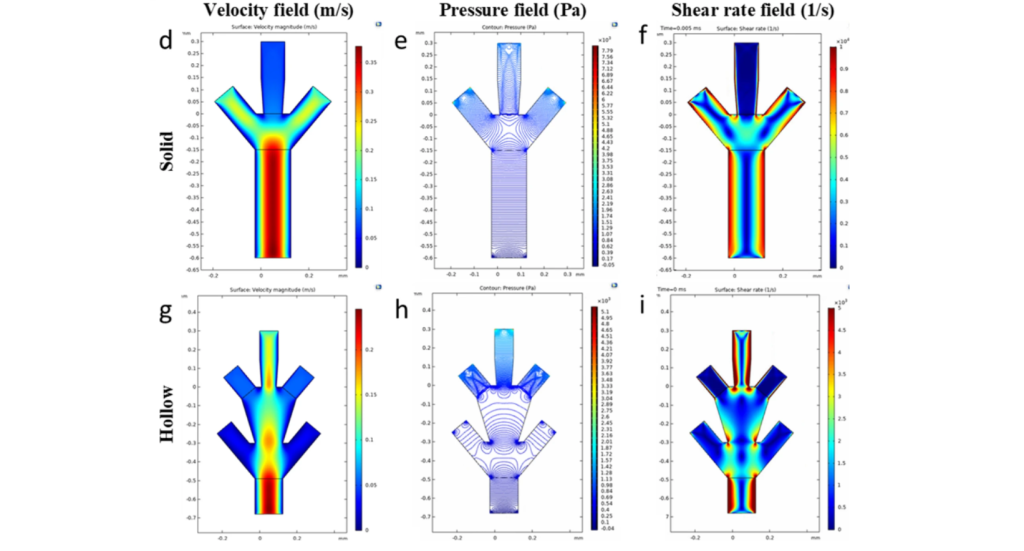China3D printingResearchers at the Stevens Institute of Technology in New Jersey are using computational modeling to advance microfluidics-based 3D bioprinting, which they hope will one day be able to fabricate entire human organs.
Many of today’s state-of-the-art bioprinters are based on extrusion processes that deposit bioinks through nozzles to create tissue structures on the order of 200 microns in size.
Instead, microfluidic-based bioprinters will operate by precisely manipulating liquids through tiny channels, and can print structures as small as tens of micrometers in size. This is more akin to the single-cell scale, which is reportedly needed if we want to make 3D printed organs a reality.
Robert Chang, associate professor in the Stevens Shaffer School of Engineering and Science, who led the work, explained: “Scale is very important because it affects the biology of the organ. We operate at the scale of human cells, which allows us to print out A structure that mimics the biological feature we’re trying to replicate.”

A scientist using a CELLINK 3D bioprinter.
BICO’s Bio X 3D bioprinter, an extrusion-based system. Photo via BICO.
Towards Human Organ Transplantation
Organ transplants can save lives for people with serious illnesses, but there has been a lack of suitable donors. In the United States, there are currently more than 100,000 patients on the transplant waiting list, and about 17 people die every day while waiting for a donor.
3D bioprinting has long been considered a potential solution to this problem, but a lack of technological development means we’re not quite there yet. For now, bioprinters excel at making simple single-cell tissues and structures, but Chang and his team believe that microfluidics could be the key to designing nearly any type of complex tissue. This includes entire vital organs and even skin printed directly on open wounds.
“Creating new organs to order and save lives without the need for human donors will have huge benefits for healthcare,” Chang said. “Achieving this goal is tricky, however, because printing organs using bioinks (hydrogels filled with cultured cells) requires a degree of fine-grained control over the geometry and size of the printed microfibrils, which current 3D printers simply cannot. accomplish.”
In addition to allowing for a smaller scale, the microfluidic-based process will also be compatible with a variety of bioinks. Each of these bioinks may contain precursors to different cell types, so users can combine them in one printed tissue construct. This is critical for complex organs such as the liver and kidneys, which rely on multiple cell types to work together.
Computational Modeling 3D Bioprinting
Scaling the 3D bioprinting process down to tens of microns is not an easy task, requiring studies on how various parameters such as flow rate, channel structure, and hydrodynamics affect the properties of printed tissue structures. To this end, Chang and his team developed a computational model of a microfluidic printhead. The model allowed them to fine-tune parameters and predict how they might affect the process without the need for tedious physical experiments.
“Our computational model advances a formula extraction that can be used to predict various geometric parameters of fabricated structures extruded from microfluidic channels,” said Ahmadreza Zaeri, first author of the study.
By simulating the results of real-world experiments, the team can now better understand how to print various organ structures. The results will be used to develop multicellular bioinks. Chang is also working on the use of microfluidic bioprinting to create skin directly on wounds.

Schematic design and numerical modeling parameters for modeling a microfluidic printhead. Image via Stevens IoT.
China3D printingNet Comment: This is certainly not the first time that microfluidics has made headlines in the field of additive manufacturing. Earlier this year, North Carolina-based medical 3D printing startup Phase Inc partnered with Virginia Tech to advance the field of microfluidic 3D printing. Phase and Virginia Tech will jointly use the former’s proprietary LE3D printing technology to develop novel microfluidic devices that will help researchers develop new and improved medical treatments for diseases such as brain cancer.
Elsewhere, researchers at the University of Bristol have previously developed a novel, low-cost and open-source 3D printing process for producing microfluidic devices. Requiring only simple home equipment and a standard desktop 3D printer, and already developed in free-to-use software, the researchers’ process reduces the cost and complexity of making microfluidics, making the field more accessible.
(responsible editor: admin)


0 Comments for “Researchers turn to microfluidics in hopes of 3D printing human organs”